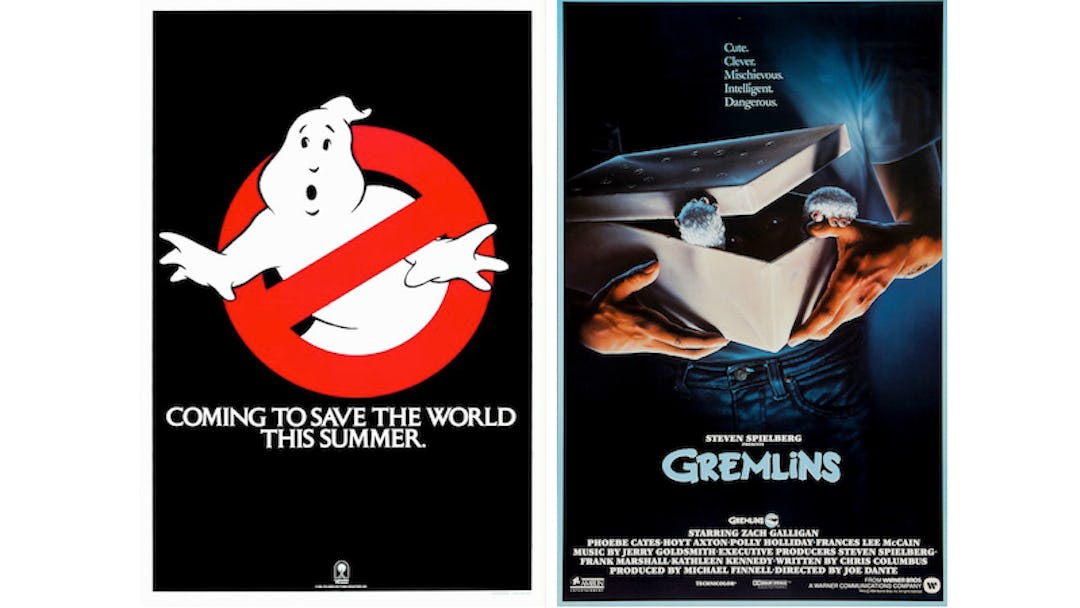We tend to think of the releases of iconic movies as standalone events, like the world came to a crashing halt so everyone could go stand in lines around the block for Star Wars or Jaws or Jurassic Park. But the movies are a business, and rare is the week that doesn’t see multiple releases, which can make for some interesting juxtapositions. (True story: the big movie on Star Wars opening weekend was supposed to be Smokey and the Bandit.) Most of the time, such competition falls into the realm of counter-programming, which was what made June 8, 1984 so peculiar: the two new wide releases of that day were both pitched towards the same general audience, the families-and-teens crowd that had become the bread and butter of the summer movie business. Both would open well — only separated by about a million bucks — and would end up the second- and fourth-highest-grossing movies of the year. More importantly, both would remain beloved pop culture classics, buoyed by a uniquely ambitious mixture of genres that is seldom attempted today. The films were Ghostbusters and Gremlins, and they both turned 30 years old yesterday.
Both arrived in theaters after lengthy gestation periods. Dan Aykroyd had written his first draft of Ghostbusters as a vehicle for himself and frequent collaborator John Belushi, putting it aside after Belushi’s death in 1982; it was a far more ambitious (and expensive) romp through various times and dimensions, which director Ivan Reitman encouraged Aykroyd to simplify and reshape with the help of co-writer (and eventual co-star) Harold Ramis. Gremlins scribe Chris Columbus (who would go on to make a mint directing Home Alone) hadn’t intended the script as anything more than a writing sample, penned on spec to get more work. But it made its way to the desk of Steven Spielberg, who bought it and would serve as its executive producer.
On that fated opening weekend in 1984, Ghostbusters topped the box office charts, bringing in $13.5 million; Gremlins was close behind at $12.5 million. They would share the top two spots for an astonishing six straight weeks that summer, and by the end of the year, Ghostbusters accumulated a total gross of $229 million domestic ($291 million worldwide), while Gremlins racked up $153 million domestic.
What was it about these two films that so captured the hearts of moviegoers — both then and in the ensuing years? There’s no question that they were very much of their moment; Ghostbusters with its stealth Reagan-era, pro-business, anti-regulation messaging, Gremlins pushing (and ultimately exploding) a quaint vision of small-town America that seemed straight out of the “morning in America” ads from Reagan’s concurrent re-election campaign. You can’t plan on timing, but the two pictures hit the precise sweet spot for 1984 audiences, in ways that even their own 1989 and 1990 sequels couldn’t replicate.
But there was more to their success than luck. Both Ghostbusters and Gremlins worked with a specific genre stew that is, oddly, barely even cooked up these days: the effects-heavy fantasy/comedy. Sure, garbage like the Transformers flicks will toss in scenes of desperate “comic relief,” and better blockbusters like The Avengers, Iron Man 3, and Edge of Tomorrow bookend their loud action beats with gags, character humor, in-jokes, and genuine wit. But that’s not why they’re there, and when the time comes, jokes are quickly jettisoned for their blow-shit-up climaxes.
Not so with Ghostbusters and Gremlins, which are comedies first, with special effects serving the jokes, and not the other way around. Gremlins has a lengthy third act which basically consists of the title creatures wreaking havoc, but Joe Dante has a sly sense of humor and a keen way of framing a joke (both developed during his years at the Corman factory), and instead of merely capturing the chaos, he gets his biggest laughs in the home stretch — while also quite literally pushing the boundaries of the PG rating. (This film and Spielberg’s Indiana Jones and the Temple of Doom, released a few works earlier, led directly to the establishment of the PG-13.)
Ghostbusters, meanwhile, culminates with a demonic takeover of a Manhattan highrise and the possibility of life on this planet coming to a rapid conclusion, but that doesn’t mean it makes the mistake of taking any of that seriously; the film treats Gozer, the inter-dimensional portal, and the Stay Puft Marshmallow Man as comedy props, while Murray and his team continue to wisecrack away like Hope and Crosby. (“This Mr. Stay Puft’s OK! He’s a sailor, he’s in New York, we get this guy laid, we won’t have any trouble!”).
It’s still possible for marquee comedies to do bang-up summer business — The Heat and We’re the Millers did last year, Neighbors is currently doing so, and 22 Jump Street is presumably about to. It’s not that they don’t use CGI to spice up their gags, or to replicate the action films they’re often spoofing. But there’s a separation of church and state between the movies that aim to awe us and the movies that hope to make us laugh. This may be an irreconcilable economic fact; increasingly, the studios are making the bulk of the money exporting effects-laden superhero movies and action epics in foreign markets, and jokes just don’t travel as well. But if a wise filmmaker — a 21st-century Dante or Reitman — can figure out how to mate the advances in moviemaking technology with the great things happening in comedy at the moment, they just might end up with a movie we’ll still be talking about in 30 years.
